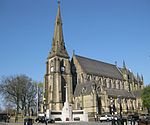Church of St Mary the Virgin, Bury
| Parish Church of St Mary the Virgin, Bury | |
|---|---|
 Parish Church of St Mary the Virgin, Bury | |
| 53°35′38″N 2°17′50″W / 53.5940°N 2.2971°W | |
| OS grid reference | SD 80433 10863 |
| Location | The Rock, Bury, Greater Manchester |
| Country | England |
| Denomination | Anglican |
| Website | Bury Parish Church |
| History | |
| Status | Parish church |
| Founded | 971 CE |
| Dedication | Virgin Mary |
| Consecrated | Candlemas 1876 |
| Architecture | |
| Functional status | Active |
| Heritage designation | Grade I |
| Designated | 13 July 2006 |
| Architect(s) | J. S. Crowther (1870 rebuild) |
| Architectural type | Church |
| Completed | 1876 |
| Specifications | |
| Length | 141 feet (43.0 m) |
| Nave width | 30 feet (9.1 m) |
| Height | 76 feet (23.2 m) |
| Materials | Dressed stone exterior partially lined in brick Slate roof |
| Bells | Eight |
| Administration | |
| Province | York |
| Diocese | Manchester |
| Archdeaconry | Bolton |
| Deanery | Bury |
| Clergy | |
| Rector | Revd. Julian Heaton |
| Curate(s) | Samuel Eccleston; Sheila Beattie; Craig Giles. |
| Laity | |
| Director of music | Marc Murray |
| Organist(s) | Elin Rees |
The Parish Church of St Mary the Virgin is located at the highest point in the town centre of Bury, Greater Manchester, England. It is situated on the edge of the town centre. The main body of the church was completed on 2 February 1876, the steeple predates it to 1842. It is designated in the National Heritage List for England as a Grade I listed building.[1]
History
[edit]
Church records suggest that the first church was built on the site in 971 A.D. when parishes were first formed by Edgar, King of England, although this is likely to have been a wood and thatch structure. Churches of this type of construction are thought to have been used until a church in the gothic style was completed in 1585. Between 1773 and 1780 the main body of this church was demolished and rebuilt leaving only the spire from the original church. The spire was replaced in 1842 but by 1870 the wood in the rest of the church had rotted and a new building was needed. The new church designed by the architect J. S. Crowther, leaving the 1842 spire in place, was officially opened on Candlemas Day 1876.[2]
In July 2013, the church was the scene of a military funeral for murdered British soldier Lee Rigby. The service was attended by thousands of mourners, including Prime Minister David Cameron.[3]
The church is a regimental church of the Lancashire Fusiliers and the Regimental Colours hang in the nave.[4] A former garrison church, services are held for the garrison on Remembrance Sunday, Gallipoli Sunday and on other occasions.[5]
Architecture
[edit]The building is of dressed stone with slate roofs, with a buttressed 3-stage tower with a spire. The interior features a hammerbeam and tie-beam roof and mosaic flooring. There is stained glass by Hardman and Clayton and Bell.[1]
The clock in the tower was the gift of Henry Whitehead, a former High Sheriff of Lancashire.[6]
See also
[edit]References
[edit]- ^ a b Historic England. "Parish Church of St Mary, Bury (1067236)". National Heritage List for England. Retrieved 20 December 2011.
- ^ "The History of Bury Parish Church". buryparishchurch.com. Bury Parish Church. Retrieved 8 May 2017.
- ^ "Lee Rigby: Military funeral for killed soldier". BBC News. British Broadcasting Corporation. 12 July 2013. Retrieved 8 May 2017.
- ^ "Bury St Mary the Virgin | National Churches Trust".
- ^ "First World War military campaign set to be remembered in Bury once again". 23 April 2024.
- ^ "John Whitehead's Penwortham Pictures". www.prestonhistoricalsociety.org.uk. Archived from the original on 3 January 2019. Retrieved 12 October 2021.




